Business Intelligence and Data Visualization
VerifiedAdded on 2023/06/11
|10
|1734
|70
AI Summary
This research paper explores the different models of crowd-funding and their significance in determining project success. The reward model of crowd-funding is taken into consideration, and hypotheses are developed based on previous literature. The paper finds that both higher and lower pledge rewards are significant determinants of project success. By raising reward levels, project success can be increased.
Contribute Materials
Your contribution can guide someone’s learning journey. Share your
documents today.
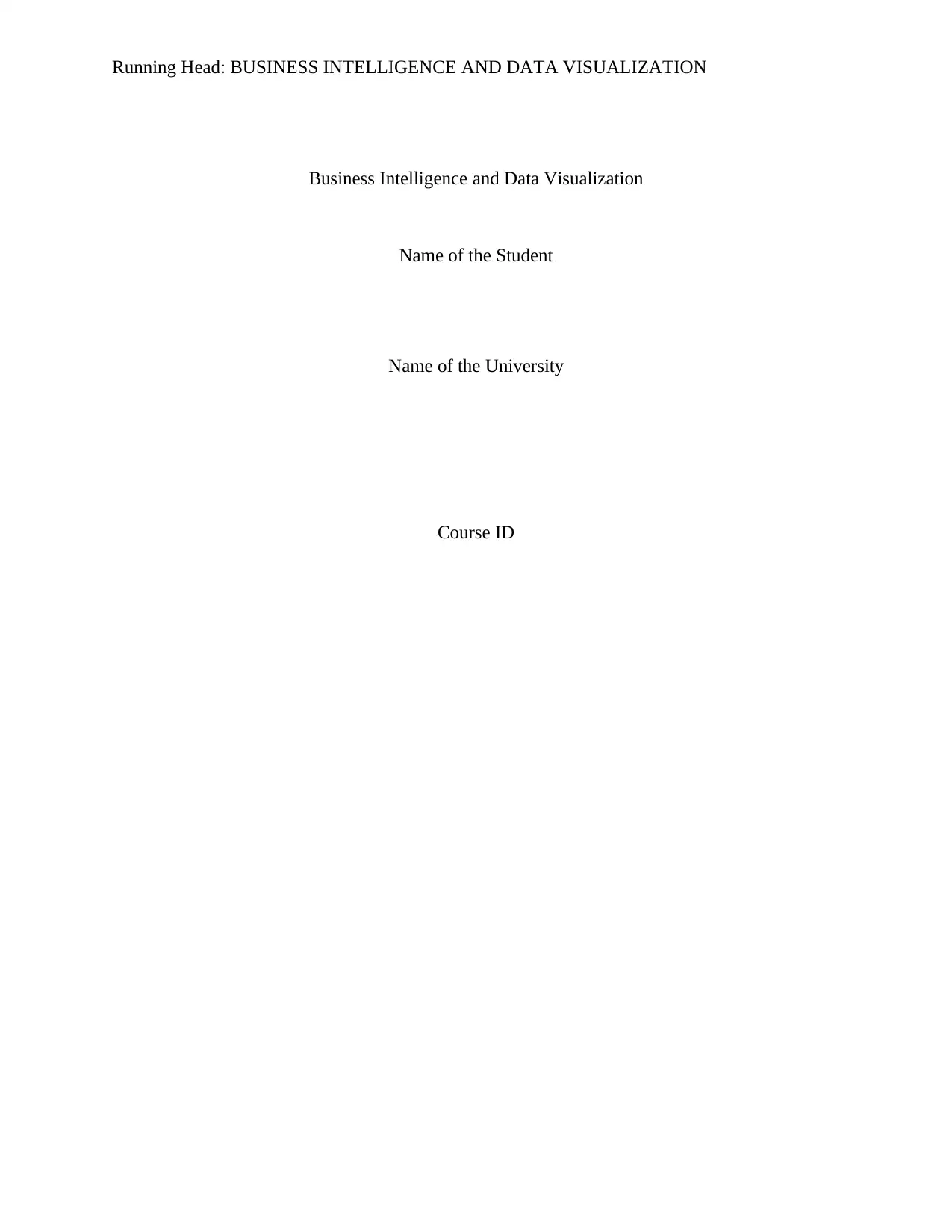
Running Head: BUSINESS INTELLIGENCE AND DATA VISUALIZATION
Business Intelligence and Data Visualization
Name of the Student
Name of the University
Course ID
Business Intelligence and Data Visualization
Name of the Student
Name of the University
Course ID
Secure Best Marks with AI Grader
Need help grading? Try our AI Grader for instant feedback on your assignments.
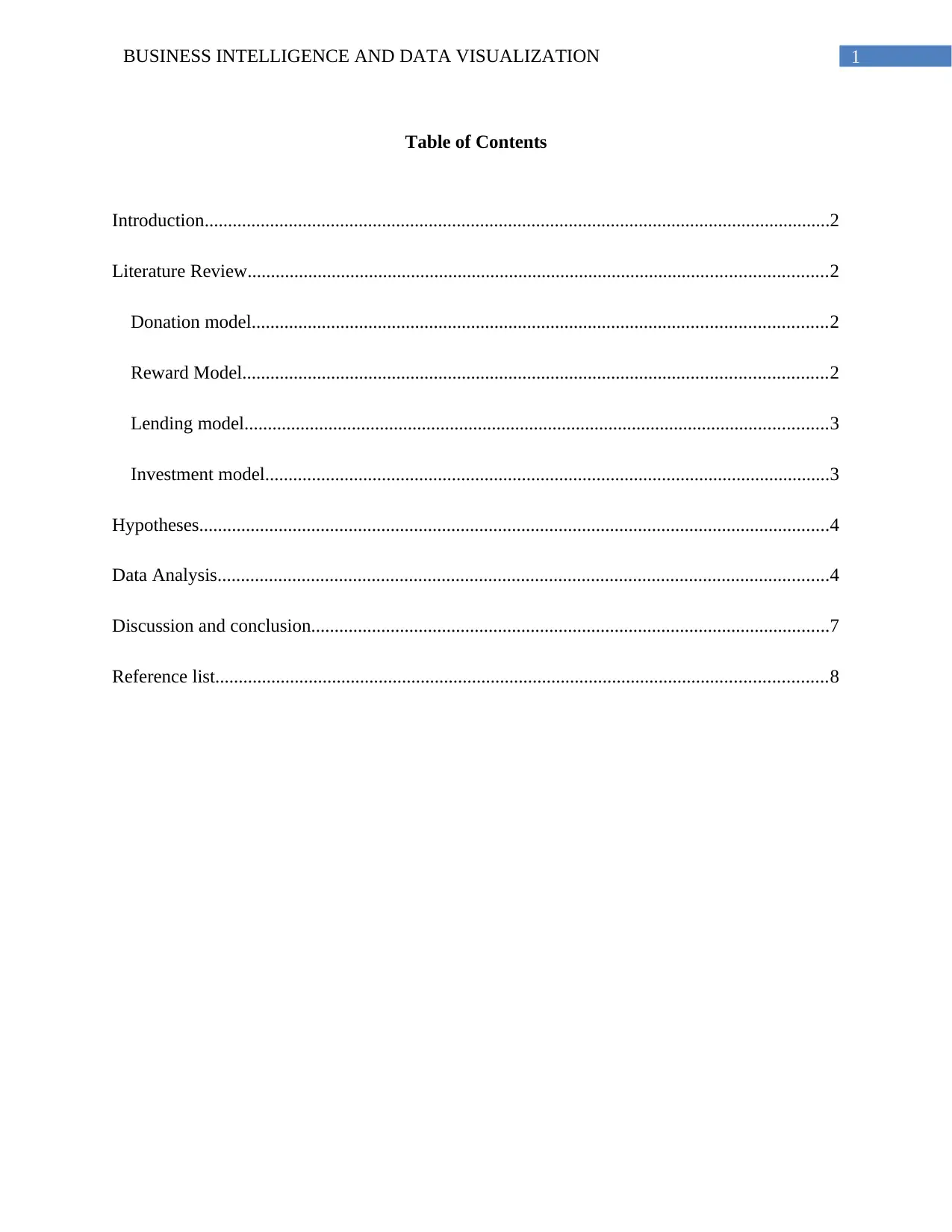
1BUSINESS INTELLIGENCE AND DATA VISUALIZATION
Table of Contents
Introduction......................................................................................................................................2
Literature Review............................................................................................................................2
Donation model...........................................................................................................................2
Reward Model.............................................................................................................................2
Lending model.............................................................................................................................3
Investment model.........................................................................................................................3
Hypotheses.......................................................................................................................................4
Data Analysis...................................................................................................................................4
Discussion and conclusion...............................................................................................................7
Reference list...................................................................................................................................8
Table of Contents
Introduction......................................................................................................................................2
Literature Review............................................................................................................................2
Donation model...........................................................................................................................2
Reward Model.............................................................................................................................2
Lending model.............................................................................................................................3
Investment model.........................................................................................................................3
Hypotheses.......................................................................................................................................4
Data Analysis...................................................................................................................................4
Discussion and conclusion...............................................................................................................7
Reference list...................................................................................................................................8
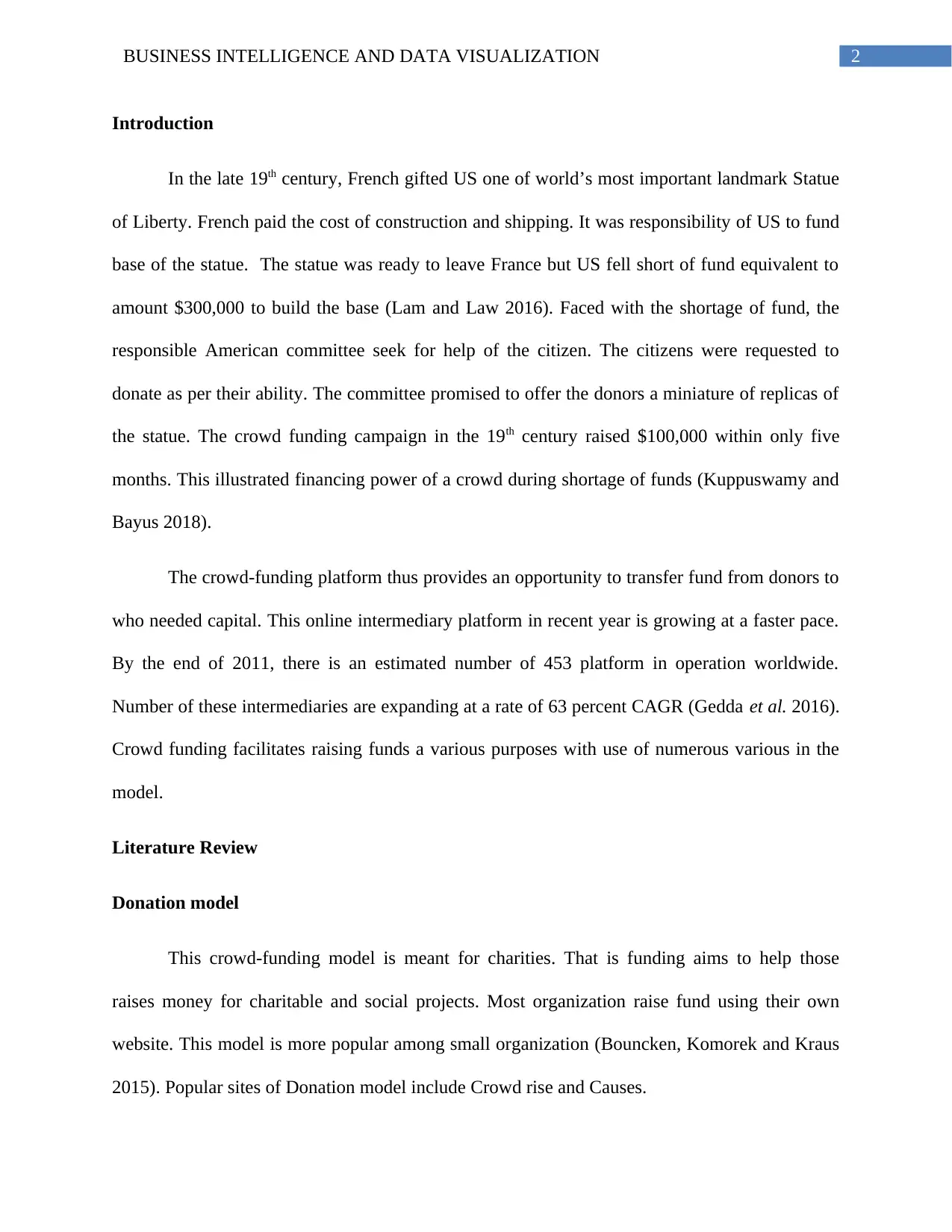
2BUSINESS INTELLIGENCE AND DATA VISUALIZATION
Introduction
In the late 19th century, French gifted US one of world’s most important landmark Statue
of Liberty. French paid the cost of construction and shipping. It was responsibility of US to fund
base of the statue. The statue was ready to leave France but US fell short of fund equivalent to
amount $300,000 to build the base (Lam and Law 2016). Faced with the shortage of fund, the
responsible American committee seek for help of the citizen. The citizens were requested to
donate as per their ability. The committee promised to offer the donors a miniature of replicas of
the statue. The crowd funding campaign in the 19th century raised $100,000 within only five
months. This illustrated financing power of a crowd during shortage of funds (Kuppuswamy and
Bayus 2018).
The crowd-funding platform thus provides an opportunity to transfer fund from donors to
who needed capital. This online intermediary platform in recent year is growing at a faster pace.
By the end of 2011, there is an estimated number of 453 platform in operation worldwide.
Number of these intermediaries are expanding at a rate of 63 percent CAGR (Gedda et al. 2016).
Crowd funding facilitates raising funds a various purposes with use of numerous various in the
model.
Literature Review
Donation model
This crowd-funding model is meant for charities. That is funding aims to help those
raises money for charitable and social projects. Most organization raise fund using their own
website. This model is more popular among small organization (Bouncken, Komorek and Kraus
2015). Popular sites of Donation model include Crowd rise and Causes.
Introduction
In the late 19th century, French gifted US one of world’s most important landmark Statue
of Liberty. French paid the cost of construction and shipping. It was responsibility of US to fund
base of the statue. The statue was ready to leave France but US fell short of fund equivalent to
amount $300,000 to build the base (Lam and Law 2016). Faced with the shortage of fund, the
responsible American committee seek for help of the citizen. The citizens were requested to
donate as per their ability. The committee promised to offer the donors a miniature of replicas of
the statue. The crowd funding campaign in the 19th century raised $100,000 within only five
months. This illustrated financing power of a crowd during shortage of funds (Kuppuswamy and
Bayus 2018).
The crowd-funding platform thus provides an opportunity to transfer fund from donors to
who needed capital. This online intermediary platform in recent year is growing at a faster pace.
By the end of 2011, there is an estimated number of 453 platform in operation worldwide.
Number of these intermediaries are expanding at a rate of 63 percent CAGR (Gedda et al. 2016).
Crowd funding facilitates raising funds a various purposes with use of numerous various in the
model.
Literature Review
Donation model
This crowd-funding model is meant for charities. That is funding aims to help those
raises money for charitable and social projects. Most organization raise fund using their own
website. This model is more popular among small organization (Bouncken, Komorek and Kraus
2015). Popular sites of Donation model include Crowd rise and Causes.
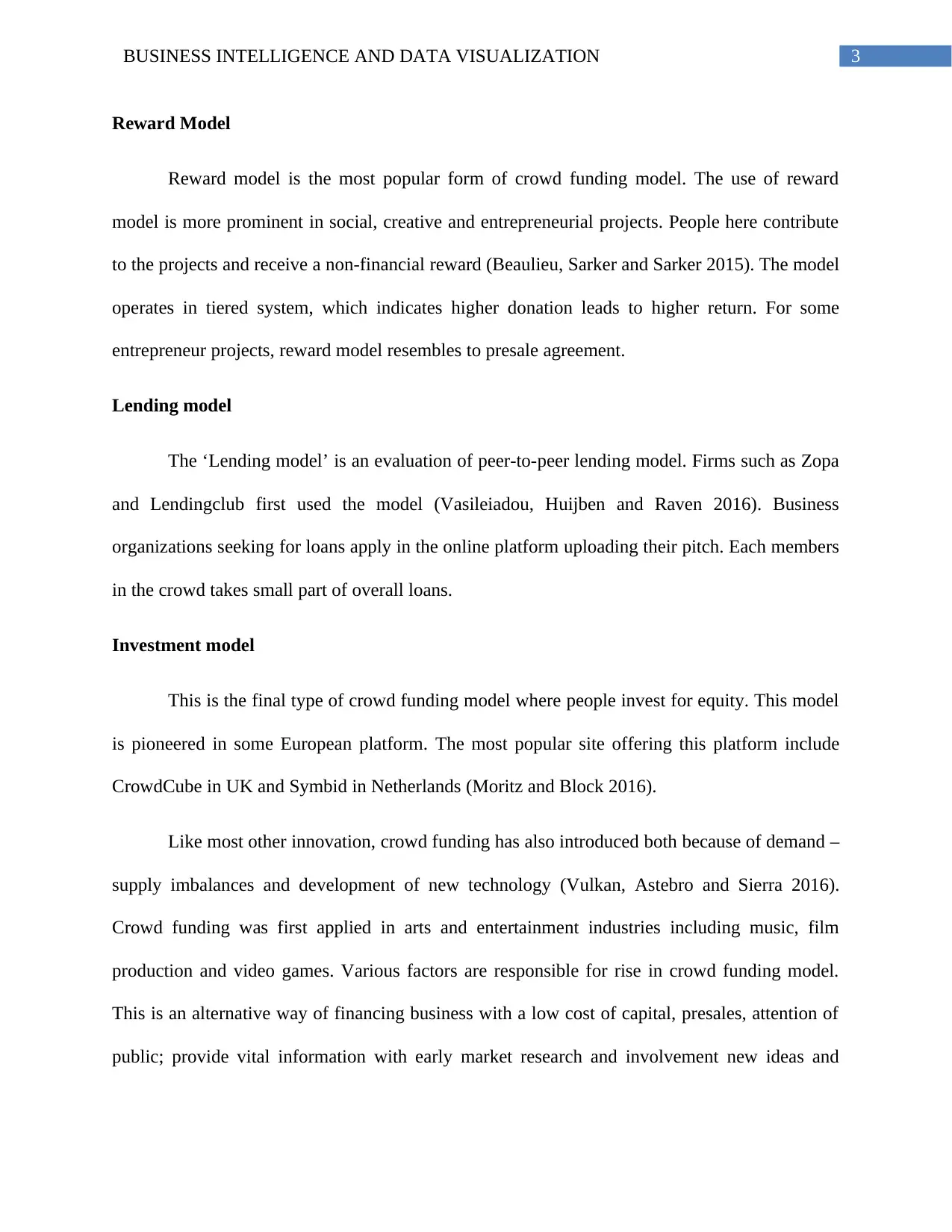
3BUSINESS INTELLIGENCE AND DATA VISUALIZATION
Reward Model
Reward model is the most popular form of crowd funding model. The use of reward
model is more prominent in social, creative and entrepreneurial projects. People here contribute
to the projects and receive a non-financial reward (Beaulieu, Sarker and Sarker 2015). The model
operates in tiered system, which indicates higher donation leads to higher return. For some
entrepreneur projects, reward model resembles to presale agreement.
Lending model
The ‘Lending model’ is an evaluation of peer-to-peer lending model. Firms such as Zopa
and Lendingclub first used the model (Vasileiadou, Huijben and Raven 2016). Business
organizations seeking for loans apply in the online platform uploading their pitch. Each members
in the crowd takes small part of overall loans.
Investment model
This is the final type of crowd funding model where people invest for equity. This model
is pioneered in some European platform. The most popular site offering this platform include
CrowdCube in UK and Symbid in Netherlands (Moritz and Block 2016).
Like most other innovation, crowd funding has also introduced both because of demand –
supply imbalances and development of new technology (Vulkan, Astebro and Sierra 2016).
Crowd funding was first applied in arts and entertainment industries including music, film
production and video games. Various factors are responsible for rise in crowd funding model.
This is an alternative way of financing business with a low cost of capital, presales, attention of
public; provide vital information with early market research and involvement new ideas and
Reward Model
Reward model is the most popular form of crowd funding model. The use of reward
model is more prominent in social, creative and entrepreneurial projects. People here contribute
to the projects and receive a non-financial reward (Beaulieu, Sarker and Sarker 2015). The model
operates in tiered system, which indicates higher donation leads to higher return. For some
entrepreneur projects, reward model resembles to presale agreement.
Lending model
The ‘Lending model’ is an evaluation of peer-to-peer lending model. Firms such as Zopa
and Lendingclub first used the model (Vasileiadou, Huijben and Raven 2016). Business
organizations seeking for loans apply in the online platform uploading their pitch. Each members
in the crowd takes small part of overall loans.
Investment model
This is the final type of crowd funding model where people invest for equity. This model
is pioneered in some European platform. The most popular site offering this platform include
CrowdCube in UK and Symbid in Netherlands (Moritz and Block 2016).
Like most other innovation, crowd funding has also introduced both because of demand –
supply imbalances and development of new technology (Vulkan, Astebro and Sierra 2016).
Crowd funding was first applied in arts and entertainment industries including music, film
production and video games. Various factors are responsible for rise in crowd funding model.
This is an alternative way of financing business with a low cost of capital, presales, attention of
public; provide vital information with early market research and involvement new ideas and
Secure Best Marks with AI Grader
Need help grading? Try our AI Grader for instant feedback on your assignments.
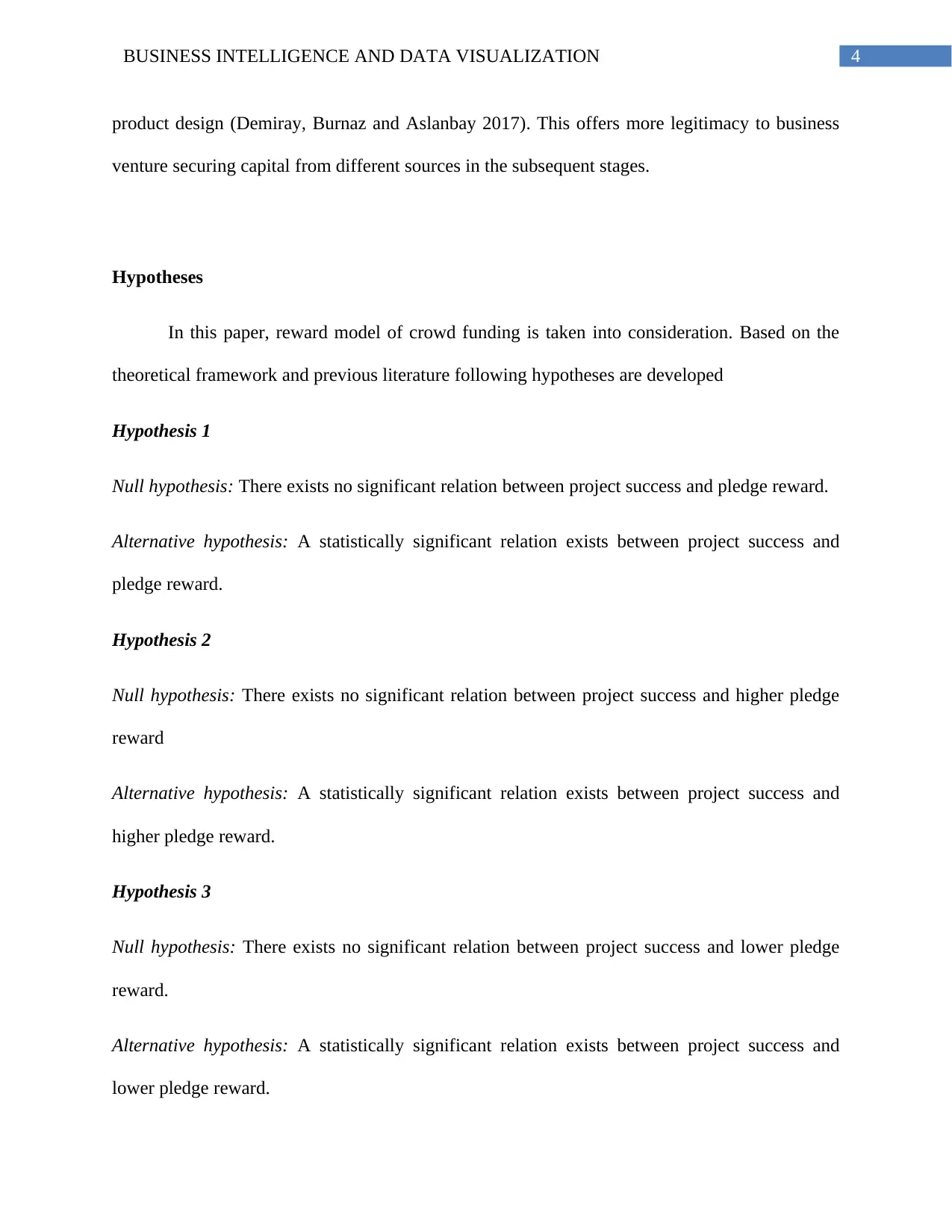
4BUSINESS INTELLIGENCE AND DATA VISUALIZATION
product design (Demiray, Burnaz and Aslanbay 2017). This offers more legitimacy to business
venture securing capital from different sources in the subsequent stages.
Hypotheses
In this paper, reward model of crowd funding is taken into consideration. Based on the
theoretical framework and previous literature following hypotheses are developed
Hypothesis 1
Null hypothesis: There exists no significant relation between project success and pledge reward.
Alternative hypothesis: A statistically significant relation exists between project success and
pledge reward.
Hypothesis 2
Null hypothesis: There exists no significant relation between project success and higher pledge
reward
Alternative hypothesis: A statistically significant relation exists between project success and
higher pledge reward.
Hypothesis 3
Null hypothesis: There exists no significant relation between project success and lower pledge
reward.
Alternative hypothesis: A statistically significant relation exists between project success and
lower pledge reward.
product design (Demiray, Burnaz and Aslanbay 2017). This offers more legitimacy to business
venture securing capital from different sources in the subsequent stages.
Hypotheses
In this paper, reward model of crowd funding is taken into consideration. Based on the
theoretical framework and previous literature following hypotheses are developed
Hypothesis 1
Null hypothesis: There exists no significant relation between project success and pledge reward.
Alternative hypothesis: A statistically significant relation exists between project success and
pledge reward.
Hypothesis 2
Null hypothesis: There exists no significant relation between project success and higher pledge
reward
Alternative hypothesis: A statistically significant relation exists between project success and
higher pledge reward.
Hypothesis 3
Null hypothesis: There exists no significant relation between project success and lower pledge
reward.
Alternative hypothesis: A statistically significant relation exists between project success and
lower pledge reward.
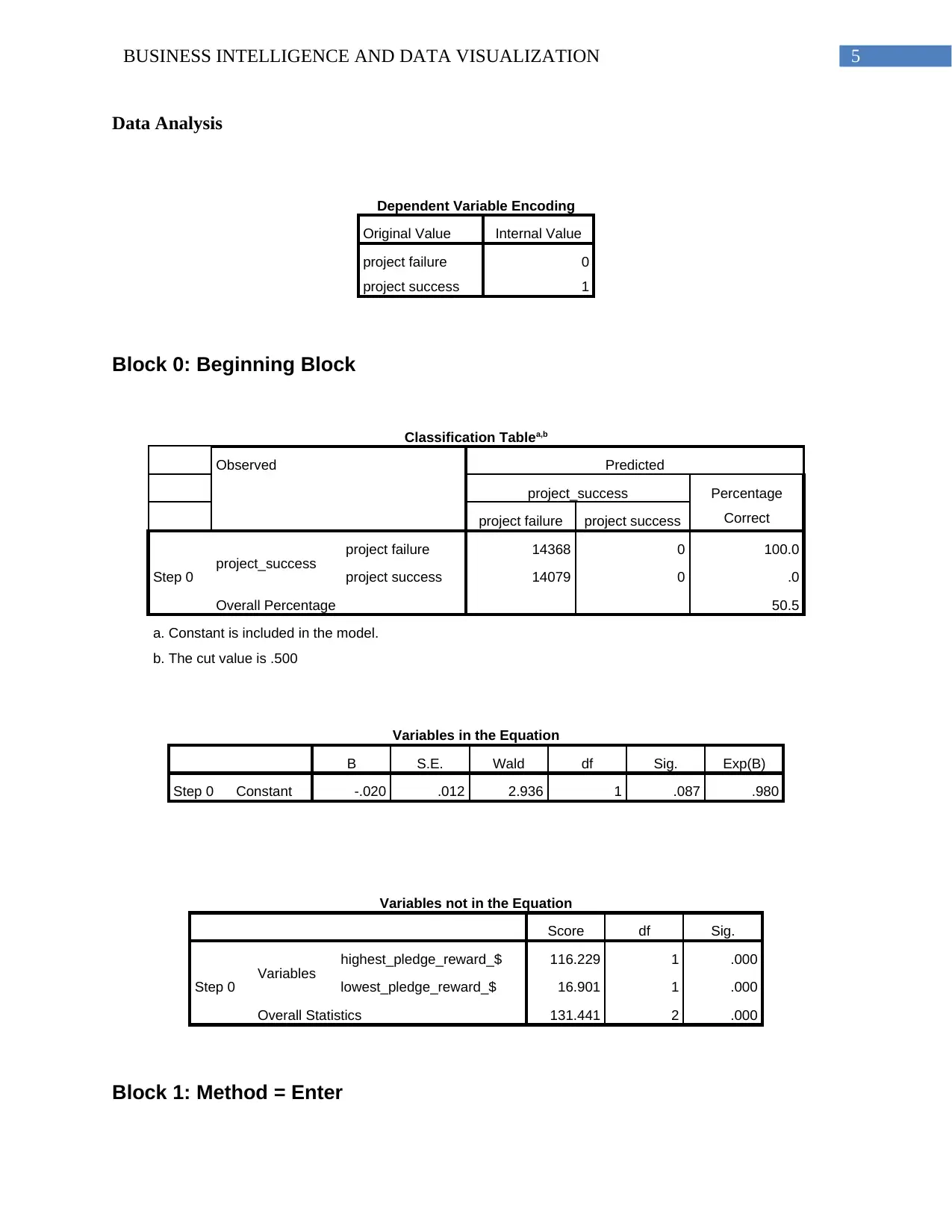
5BUSINESS INTELLIGENCE AND DATA VISUALIZATION
Data Analysis
Dependent Variable Encoding
Original Value Internal Value
project failure 0
project success 1
Block 0: Beginning Block
Classification Tablea,b
Observed Predicted
project_success Percentage
Correctproject failure project success
Step 0 project_success project failure 14368 0 100.0
project success 14079 0 .0
Overall Percentage 50.5
a. Constant is included in the model.
b. The cut value is .500
Variables in the Equation
B S.E. Wald df Sig. Exp(B)
Step 0 Constant -.020 .012 2.936 1 .087 .980
Variables not in the Equation
Score df Sig.
Step 0 Variables highest_pledge_reward_$ 116.229 1 .000
lowest_pledge_reward_$ 16.901 1 .000
Overall Statistics 131.441 2 .000
Block 1: Method = Enter
Data Analysis
Dependent Variable Encoding
Original Value Internal Value
project failure 0
project success 1
Block 0: Beginning Block
Classification Tablea,b
Observed Predicted
project_success Percentage
Correctproject failure project success
Step 0 project_success project failure 14368 0 100.0
project success 14079 0 .0
Overall Percentage 50.5
a. Constant is included in the model.
b. The cut value is .500
Variables in the Equation
B S.E. Wald df Sig. Exp(B)
Step 0 Constant -.020 .012 2.936 1 .087 .980
Variables not in the Equation
Score df Sig.
Step 0 Variables highest_pledge_reward_$ 116.229 1 .000
lowest_pledge_reward_$ 16.901 1 .000
Overall Statistics 131.441 2 .000
Block 1: Method = Enter
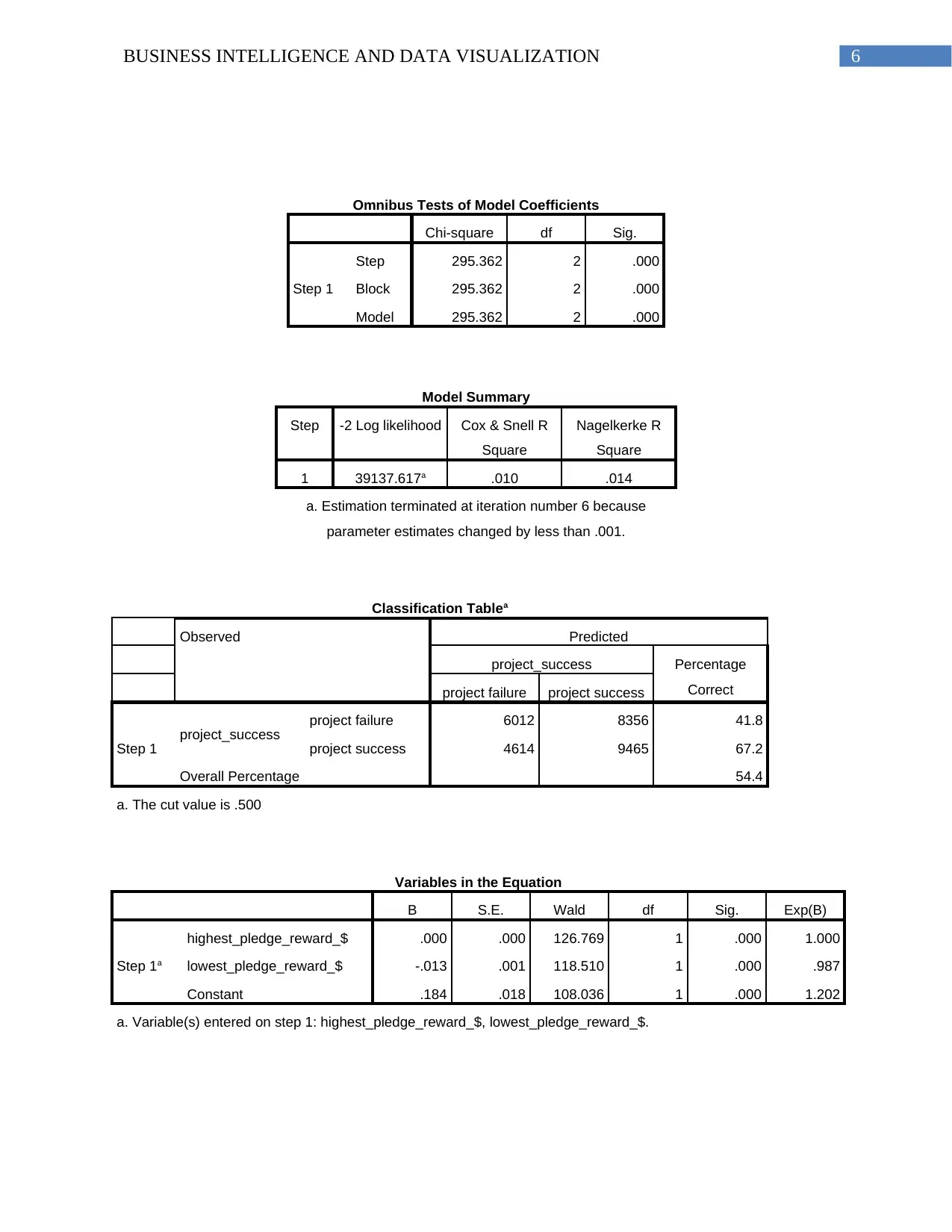
6BUSINESS INTELLIGENCE AND DATA VISUALIZATION
Omnibus Tests of Model Coefficients
Chi-square df Sig.
Step 1
Step 295.362 2 .000
Block 295.362 2 .000
Model 295.362 2 .000
Model Summary
Step -2 Log likelihood Cox & Snell R
Square
Nagelkerke R
Square
1 39137.617a .010 .014
a. Estimation terminated at iteration number 6 because
parameter estimates changed by less than .001.
Classification Tablea
Observed Predicted
project_success Percentage
Correctproject failure project success
Step 1 project_success project failure 6012 8356 41.8
project success 4614 9465 67.2
Overall Percentage 54.4
a. The cut value is .500
Variables in the Equation
B S.E. Wald df Sig. Exp(B)
Step 1a
highest_pledge_reward_$ .000 .000 126.769 1 .000 1.000
lowest_pledge_reward_$ -.013 .001 118.510 1 .000 .987
Constant .184 .018 108.036 1 .000 1.202
a. Variable(s) entered on step 1: highest_pledge_reward_$, lowest_pledge_reward_$.
Omnibus Tests of Model Coefficients
Chi-square df Sig.
Step 1
Step 295.362 2 .000
Block 295.362 2 .000
Model 295.362 2 .000
Model Summary
Step -2 Log likelihood Cox & Snell R
Square
Nagelkerke R
Square
1 39137.617a .010 .014
a. Estimation terminated at iteration number 6 because
parameter estimates changed by less than .001.
Classification Tablea
Observed Predicted
project_success Percentage
Correctproject failure project success
Step 1 project_success project failure 6012 8356 41.8
project success 4614 9465 67.2
Overall Percentage 54.4
a. The cut value is .500
Variables in the Equation
B S.E. Wald df Sig. Exp(B)
Step 1a
highest_pledge_reward_$ .000 .000 126.769 1 .000 1.000
lowest_pledge_reward_$ -.013 .001 118.510 1 .000 .987
Constant .184 .018 108.036 1 .000 1.202
a. Variable(s) entered on step 1: highest_pledge_reward_$, lowest_pledge_reward_$.
Paraphrase This Document
Need a fresh take? Get an instant paraphrase of this document with our AI Paraphraser
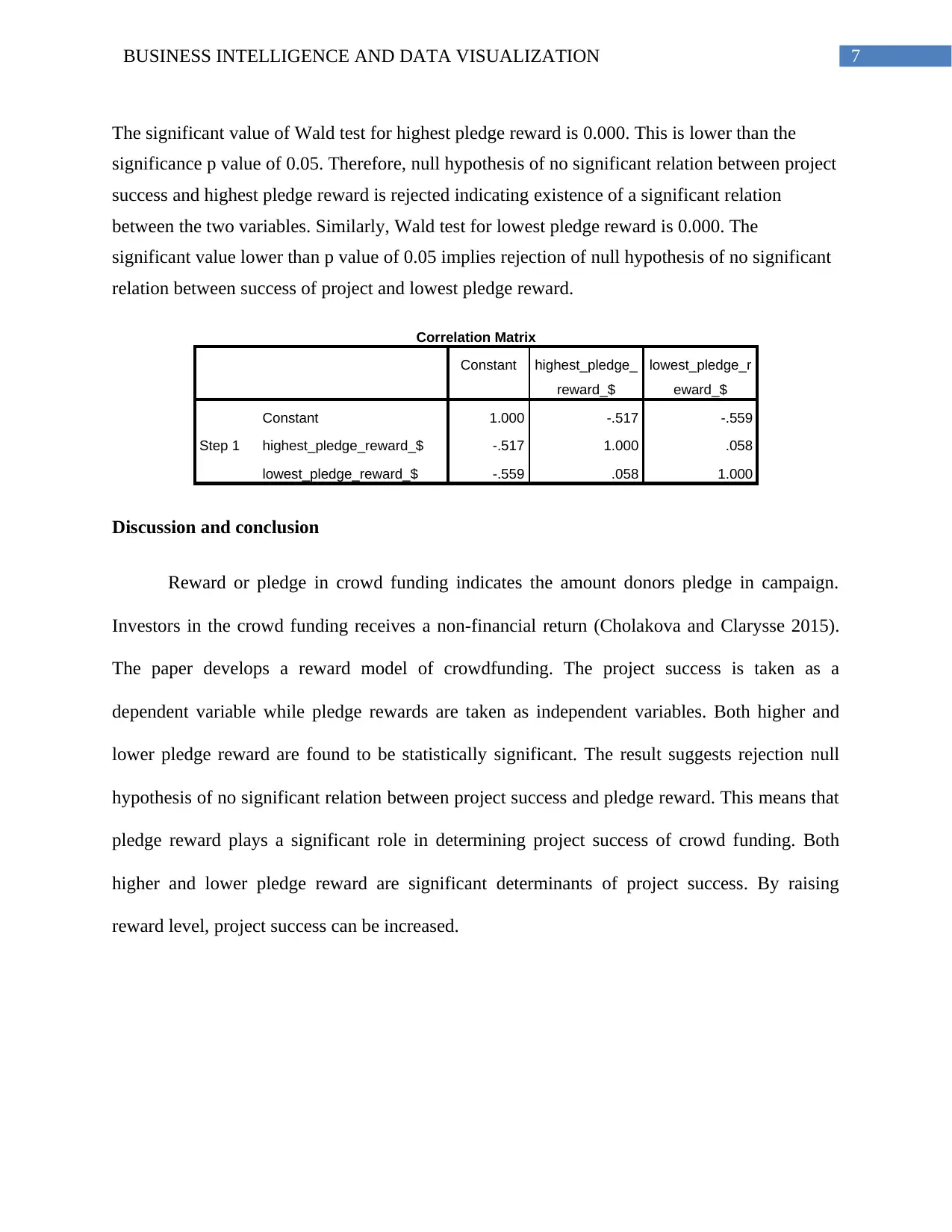
7BUSINESS INTELLIGENCE AND DATA VISUALIZATION
The significant value of Wald test for highest pledge reward is 0.000. This is lower than the
significance p value of 0.05. Therefore, null hypothesis of no significant relation between project
success and highest pledge reward is rejected indicating existence of a significant relation
between the two variables. Similarly, Wald test for lowest pledge reward is 0.000. The
significant value lower than p value of 0.05 implies rejection of null hypothesis of no significant
relation between success of project and lowest pledge reward.
Correlation Matrix
Constant highest_pledge_
reward_$
lowest_pledge_r
eward_$
Step 1
Constant 1.000 -.517 -.559
highest_pledge_reward_$ -.517 1.000 .058
lowest_pledge_reward_$ -.559 .058 1.000
Discussion and conclusion
Reward or pledge in crowd funding indicates the amount donors pledge in campaign.
Investors in the crowd funding receives a non-financial return (Cholakova and Clarysse 2015).
The paper develops a reward model of crowdfunding. The project success is taken as a
dependent variable while pledge rewards are taken as independent variables. Both higher and
lower pledge reward are found to be statistically significant. The result suggests rejection null
hypothesis of no significant relation between project success and pledge reward. This means that
pledge reward plays a significant role in determining project success of crowd funding. Both
higher and lower pledge reward are significant determinants of project success. By raising
reward level, project success can be increased.
The significant value of Wald test for highest pledge reward is 0.000. This is lower than the
significance p value of 0.05. Therefore, null hypothesis of no significant relation between project
success and highest pledge reward is rejected indicating existence of a significant relation
between the two variables. Similarly, Wald test for lowest pledge reward is 0.000. The
significant value lower than p value of 0.05 implies rejection of null hypothesis of no significant
relation between success of project and lowest pledge reward.
Correlation Matrix
Constant highest_pledge_
reward_$
lowest_pledge_r
eward_$
Step 1
Constant 1.000 -.517 -.559
highest_pledge_reward_$ -.517 1.000 .058
lowest_pledge_reward_$ -.559 .058 1.000
Discussion and conclusion
Reward or pledge in crowd funding indicates the amount donors pledge in campaign.
Investors in the crowd funding receives a non-financial return (Cholakova and Clarysse 2015).
The paper develops a reward model of crowdfunding. The project success is taken as a
dependent variable while pledge rewards are taken as independent variables. Both higher and
lower pledge reward are found to be statistically significant. The result suggests rejection null
hypothesis of no significant relation between project success and pledge reward. This means that
pledge reward plays a significant role in determining project success of crowd funding. Both
higher and lower pledge reward are significant determinants of project success. By raising
reward level, project success can be increased.
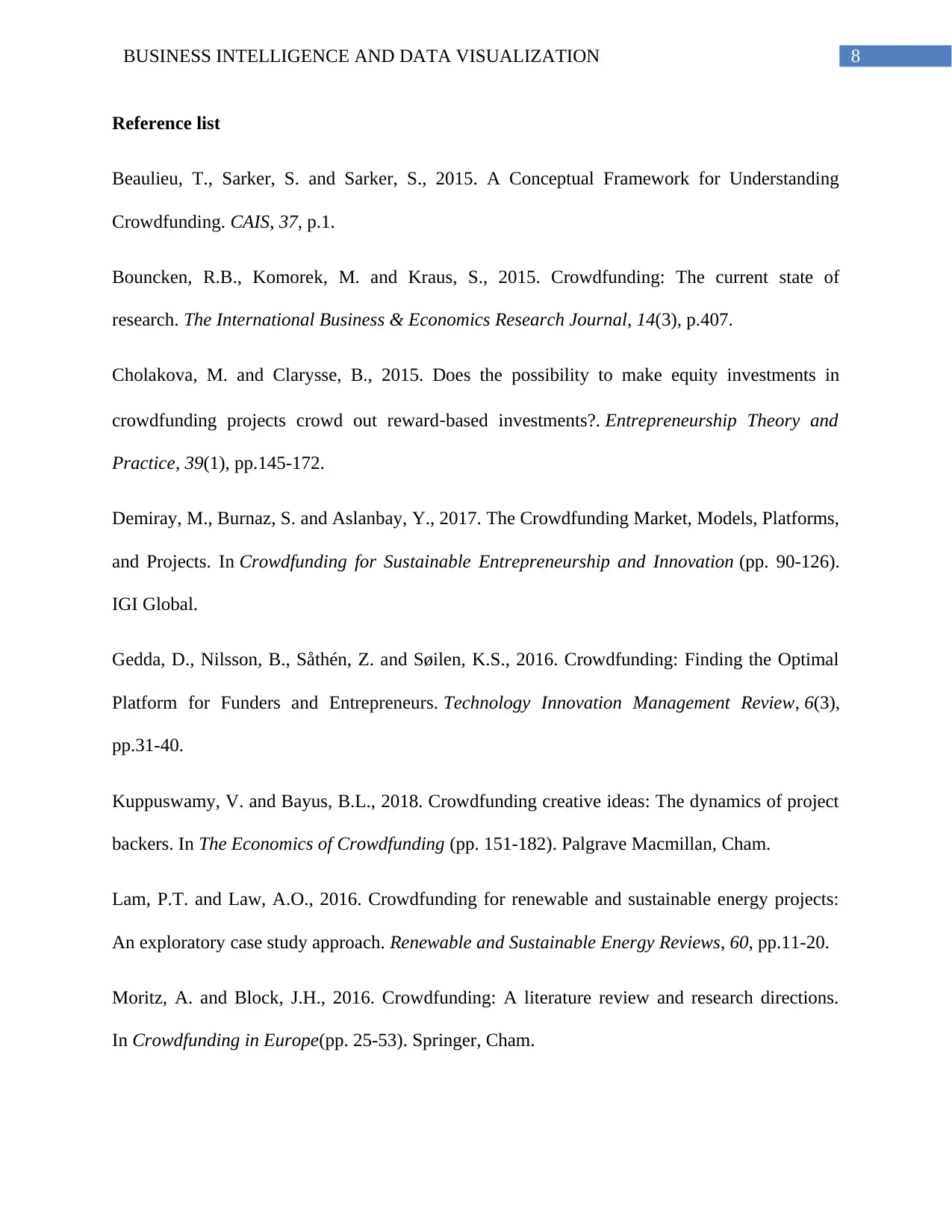
8BUSINESS INTELLIGENCE AND DATA VISUALIZATION
Reference list
Beaulieu, T., Sarker, S. and Sarker, S., 2015. A Conceptual Framework for Understanding
Crowdfunding. CAIS, 37, p.1.
Bouncken, R.B., Komorek, M. and Kraus, S., 2015. Crowdfunding: The current state of
research. The International Business & Economics Research Journal, 14(3), p.407.
Cholakova, M. and Clarysse, B., 2015. Does the possibility to make equity investments in
crowdfunding projects crowd out reward‐based investments?. Entrepreneurship Theory and
Practice, 39(1), pp.145-172.
Demiray, M., Burnaz, S. and Aslanbay, Y., 2017. The Crowdfunding Market, Models, Platforms,
and Projects. In Crowdfunding for Sustainable Entrepreneurship and Innovation (pp. 90-126).
IGI Global.
Gedda, D., Nilsson, B., Såthén, Z. and Søilen, K.S., 2016. Crowdfunding: Finding the Optimal
Platform for Funders and Entrepreneurs. Technology Innovation Management Review, 6(3),
pp.31-40.
Kuppuswamy, V. and Bayus, B.L., 2018. Crowdfunding creative ideas: The dynamics of project
backers. In The Economics of Crowdfunding (pp. 151-182). Palgrave Macmillan, Cham.
Lam, P.T. and Law, A.O., 2016. Crowdfunding for renewable and sustainable energy projects:
An exploratory case study approach. Renewable and Sustainable Energy Reviews, 60, pp.11-20.
Moritz, A. and Block, J.H., 2016. Crowdfunding: A literature review and research directions.
In Crowdfunding in Europe(pp. 25-53). Springer, Cham.
Reference list
Beaulieu, T., Sarker, S. and Sarker, S., 2015. A Conceptual Framework for Understanding
Crowdfunding. CAIS, 37, p.1.
Bouncken, R.B., Komorek, M. and Kraus, S., 2015. Crowdfunding: The current state of
research. The International Business & Economics Research Journal, 14(3), p.407.
Cholakova, M. and Clarysse, B., 2015. Does the possibility to make equity investments in
crowdfunding projects crowd out reward‐based investments?. Entrepreneurship Theory and
Practice, 39(1), pp.145-172.
Demiray, M., Burnaz, S. and Aslanbay, Y., 2017. The Crowdfunding Market, Models, Platforms,
and Projects. In Crowdfunding for Sustainable Entrepreneurship and Innovation (pp. 90-126).
IGI Global.
Gedda, D., Nilsson, B., Såthén, Z. and Søilen, K.S., 2016. Crowdfunding: Finding the Optimal
Platform for Funders and Entrepreneurs. Technology Innovation Management Review, 6(3),
pp.31-40.
Kuppuswamy, V. and Bayus, B.L., 2018. Crowdfunding creative ideas: The dynamics of project
backers. In The Economics of Crowdfunding (pp. 151-182). Palgrave Macmillan, Cham.
Lam, P.T. and Law, A.O., 2016. Crowdfunding for renewable and sustainable energy projects:
An exploratory case study approach. Renewable and Sustainable Energy Reviews, 60, pp.11-20.
Moritz, A. and Block, J.H., 2016. Crowdfunding: A literature review and research directions.
In Crowdfunding in Europe(pp. 25-53). Springer, Cham.
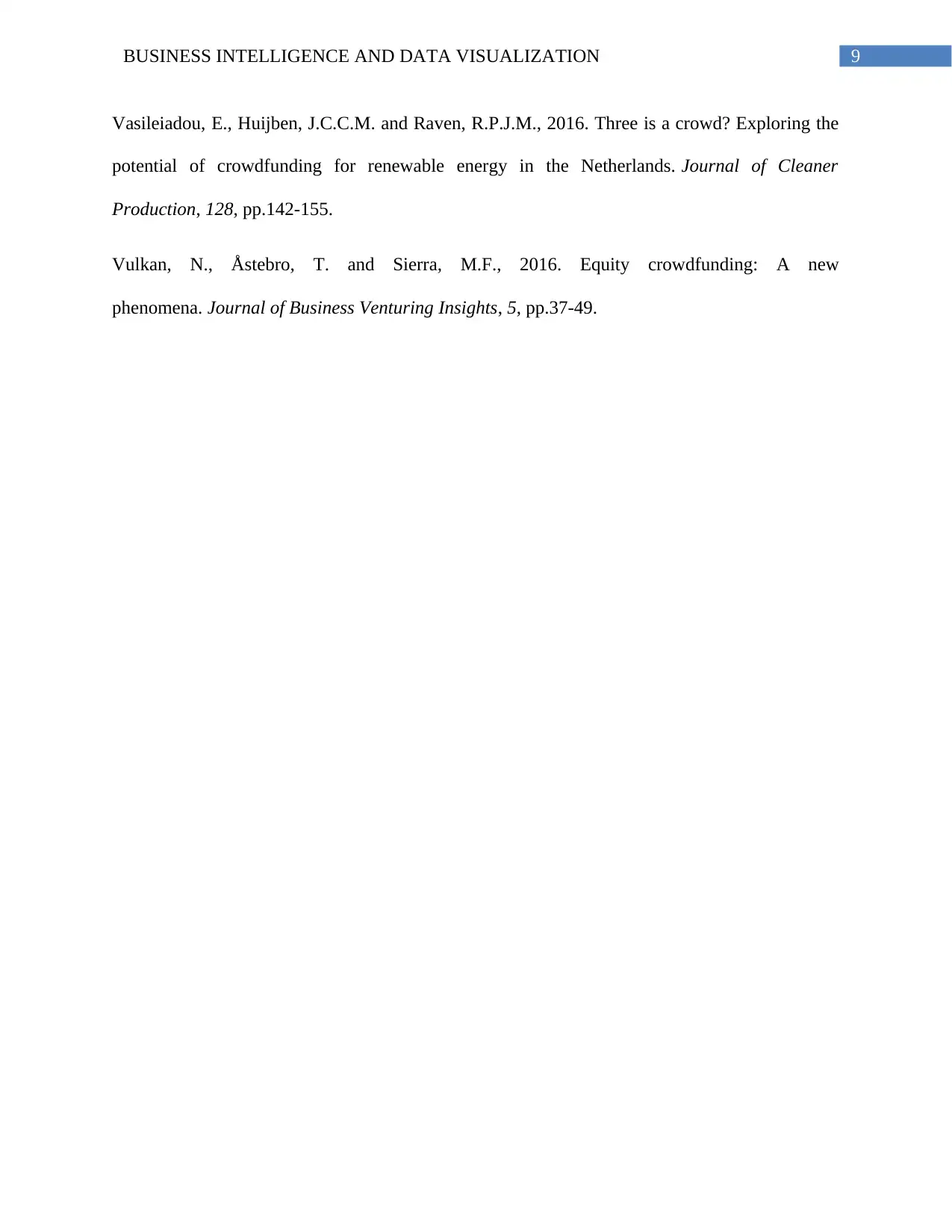
9BUSINESS INTELLIGENCE AND DATA VISUALIZATION
Vasileiadou, E., Huijben, J.C.C.M. and Raven, R.P.J.M., 2016. Three is a crowd? Exploring the
potential of crowdfunding for renewable energy in the Netherlands. Journal of Cleaner
Production, 128, pp.142-155.
Vulkan, N., Åstebro, T. and Sierra, M.F., 2016. Equity crowdfunding: A new
phenomena. Journal of Business Venturing Insights, 5, pp.37-49.
Vasileiadou, E., Huijben, J.C.C.M. and Raven, R.P.J.M., 2016. Three is a crowd? Exploring the
potential of crowdfunding for renewable energy in the Netherlands. Journal of Cleaner
Production, 128, pp.142-155.
Vulkan, N., Åstebro, T. and Sierra, M.F., 2016. Equity crowdfunding: A new
phenomena. Journal of Business Venturing Insights, 5, pp.37-49.
1 out of 10
Related Documents
Your All-in-One AI-Powered Toolkit for Academic Success.
+13062052269
info@desklib.com
Available 24*7 on WhatsApp / Email
![[object Object]](/_next/static/media/star-bottom.7253800d.svg)
Unlock your academic potential
© 2024 | Zucol Services PVT LTD | All rights reserved.
